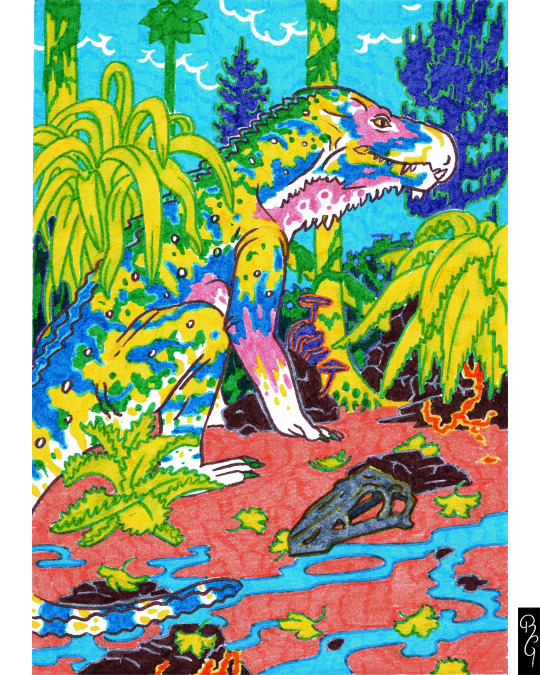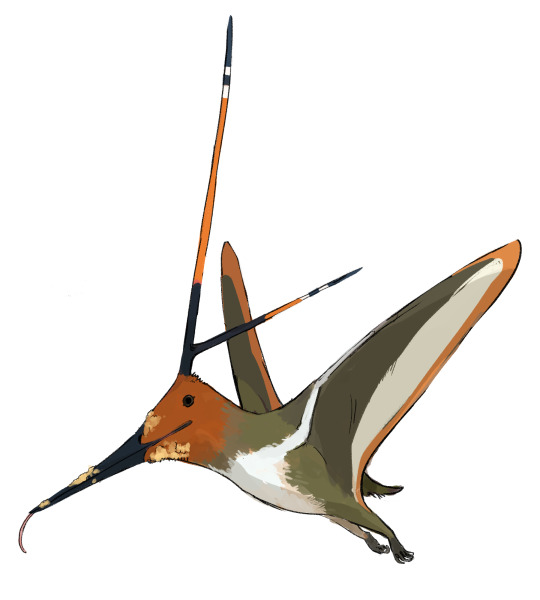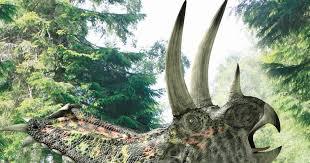#Archosauria
Text

Ischigualasto series, alternate takes:
Venaticosuchus, fiber pen, 2023
#paleoart#triassic#illustration#ischigualasto formation#archosauria#pseudosuchia#ornithosuchidae#venaticosuchus#fiber pen#fiber#abstract paleoart
193 notes
·
View notes
Text

Great horned owl (Bubo virginianus)
Photo by Dan Weisz
#great horned owl#bubo virginianus#bubo#striginae#strigidae#strigiformes#neognathae#aves#archosauria#reptilia#tetrapoda#vertebrata#chordata
627 notes
·
View notes
Text
Sketch of Shringasaurus indicus, an unusual Archosauromorph which lived in the middle Triassic of India, 247-242 million years ago

#paleoart#paleontography#triassic#mesozoic#archosaurs#archosauromorph#shringasaurus#archosaur#archosauria#triassic reptile#digital art#digital arwork
25 notes
·
View notes
Photo

Day 21: Smok wawelski
#Smok wawelski#Smok#Archosauria#Archosauromorpha#paleoart#paleoblr#palaeoblr#dinosaur#paleontology#archovember#archovember2022#dinovember#dinovember2022#art#digital art
36 notes
·
View notes
Text
Maastrichtian May challenge
In case you wanted to know what I've been drawing, I was doing this fun little drawing challenge for the month of May, made by @mrultra100.
I am also trying a different style. A mix of chibi and cartoony, inspired by the BC Builders toys of my childhood.
Figured that instead of posting all the images here, I'd post a Google drive link with ALL of the images. Gaze at my not-so-perfect but not-too-shabby sketches.
6 notes
·
View notes
Text

Fenghuangopterus
Fenghuangopterus — рід базальних птерозаврів, що мешкали на північному сході Китаю в середній юрі. Типовий вид Fenghuangopterus lii був описаний і названий у 2010 році Лю Цзюньчаном (Lü Junchang) з колегами. Родова назва походить від назви гори Фенхуан і латинізованого давньогрецького pteron, “крило”. Видова назва походить від імені Лі Сюмей (Li Xiumei), який подарував скам’янілість.
Повний текст на сайті "Вимерлий світ":
https://extinctworld.in.ua/fenghuangopterus/
#fenghuangopterus#ua#pterosaur#jurassic#jurassic period#china#archosauria#pterosauria#paleontology#paleoart#prehistoric#animals#палеоарт#палеонтологія#ukraine#ukrainian#art#animal art#digital art#extinct#fossils#illustration#daily#article#україна#мова#українська мова#арт#китай#тварини
11 notes
·
View notes
Text
Nyctosaurid Earth

Nyctosaurids were a clade of pterosaurs from the Cretaceous. They first appear right at the beginning, a humerus from Transylvania a mere few million years after the Jurassic ended. They would go on radio silence for the rest of the Cretaceous until the Campanian stage of the Late Cretaceous, where they explode in diversity alongside the other main clade of Late Cretaceous pterosaurs, the azhdarchids, presumably in response to the extinction of various groups like ornithocheirids and anhanguerids.
Nyctosaurids are very odd animals. They superficially resemble the famous Pteranodon, but have proportionally longer wings which completely lack all fingers aside from the wing fingers, meaning they essentially walked on their knuckle (singular because no other metacarpals either). Note that the hindfeet were still four toed, though poorly preserved. Some species, including Nyctosaurus proper, have remarkably huge headcrests, similar to antlers. Although it was historically thought nyctosaurids had sails, in truth the headcrest bone is smooth, meaning it was tighly hugged by its keratin sheath, like say a cassowary’s casque. So yes, antler-like.
Nyctosaurids are traditionally invisioned as highly specialised animals. Nyctosaurus proper and some related taxa like Barbaridactylus and Muzquizopteryx occur in marine sites and have some of the proportionally largest wings of all known vertebrates, suggesting that these animals were essentially akin to modern frigatebirds and albatrosses, spending most of their lives soaring away from shore. The absence of fingers aside from the wing finger and the proportionally short legs and feet would suggest that these animals were the most aerial vertebrates to have ever lived, spending most of their lives on the wing and only landing to lay eggs.
Still, a few things do not add up:
First, the longevity of this group. Note the Early Cretaceous humerus; this means an existence for at least 77 million years, passing through a few extinction events not even other pterosaurs could manage like the aforementioned ornithocheirids, which have a much less specialised morphology and by this logic ecology.
Some taxa like Alcione elainus are now known to have occupied other ecological niches, in its case being a diver like an auk.
The nyctosaurid finger loss is simply a more extreme version of what happened to most Late Cretaceous pterosaurs; most azhdarchoids and pteranodontids lost metacarpals I-III and have relatively small fingers attached to the fourth metacarpal, meaning that digits aside from the wing finger just weren’t important for pterosaurs at this point and they they were probably in the process of losing them as well.
Barring taxa like Barbaridactylus, “Nyctosaurus” lamegoi and Simurghia which could reach wingspans of five meters, most nyctosaurids were small sized pterosaurs; Nyctosaurus and Muzquizopteryx for instance have two meter wingspans, but essentially mallard-sized bodies, and Alcione doesn’t even have that long a wingspan to boot. We know that pterosaurs could fly from birth and likely occupied several niches across their lifetime, something that seems to have rung especially true for the Late Cretaceous taxa. Therefore, it is possible that some nyctosaurids were generalistic animals and perhaps even terrestrial as juveniles (this is definitely known to be the case to the possibly related Pteranodon), though Nyctosaurus itself at least seems to have taken to an open going lifestyle from very early on since juveniles are known in deep water deposits.
So, with all this said and done, imagine a timeline where young, possibly neotenic nyctosaurids managed to pass through the KT event. They’ve already survived several cataclysms before, so in this timeline they do not run out of luck. Instead of birds, the skies are theirs for the taking.
An alternative would simply be a no KT world where nyctosaurids keep on living and azhdarchids die out, just to spite all the people using azhdarchids in speculative evolution projects. But I have a brand to keep.
Them Speculative Nyctosaurs

On the onset of the KT event, many nyctosaurids quickly filled the void left by the azhdarchid giants. Adaptation for a terrestrial lifestyle likely stems from Alcione-like taxa, which already had reduced wings and stronger femora, perhaps via neoteny since the adults would have been marine piscivores. Several linages seem to have taken this path, rendering the group polyphyletic.
A split image of their azhdarchid and chaoyangopterid cousins long dead, these animals stride efficiently on the ground, the forelimbs already having ungulate-like proportions and the hindlimbs quick to catch up. They differ in possessing slightly more flexible necks due to higher number of neck vertebrae which are also smaller and possess strong muscle attachment scars (see Luchibang, another pteranodontoidean that tried the azhdarchoid lifestyle), the lack of a massive nasoantorbital fenestra and small smooth crests with no keratin expansions. Like all nyctosaurids they lack fingers aside from the wingfinger on the forelimb, but azhdarchoids had reduced fingers anyways so it makes little functional difference.
In some ways, these animals are actually more stork-like than azhdarchids, since their large, splayed hindlimb feet allow them to support their weight more efficiently in soft substrate as well as swim (the same cannot be said for the forelimbs of course, but even ctenochamatoids had small wing fingers so…). They are most common in wetland biomes, but several species also foreage on drier terrains. They are mostly carnivorous, hunting whatever small animals they can find, but a few species also feed on soft aquatic plants and berries and seeds they find on the field. A select few have turned to a raptorial lifestyle, they are are comparetively rare compared to their aerial hunting relatives.
Most species are continous flappers like ducks and bustards, but a few are also efficient soarers. Despiste their terrestrial adaptations, they rank among continental flyers, and are not going to become flightless any time soon.
Attaining wingspans of 10 meters, they are some of the largest flying animals of all time, comparable to their azhdarchid cousins.

While some nyctosaurids developed terrestrial predatory forms from the stork-like flock, most raptorial species hunt from the air. In general it didn’t take long for the frigatebird likes of Nyctosaurus and Barbaridactylus to shift from hunting on the ocean surface and coastlines to hunting large prey inland.
Although some species did developed hooked bills, most stuck to another morphology known in predatory pterosaurs: like the long gone Thalassodromeus, these species developed “scissor-like” jaw margins. In some species, these bear microserrations, similar to those found in the blade of a knife or in the teeth of predatory reptiles, allowing them to slice meat efficiently.
These aerial predators can reach immense wingspans, up to 13 meters in some cases, making them the animals with the longest wingspans (though not as heavy as some of their stork-like relatives). They target mid-sized mammals (sheep-horse size; in other words, a large variety of lambdopsalids, boffiids and similar gracile multituberculates), either snatching them from their air with their jaws or slicing pieces of flesh from their flanks and back. They are highly acrobatic, so only the smallest and more agile can evade the jaws of death.
A number of species instead specialised in hunting in other nyctosaurs and flying mammals, startingly them so they take off. Once in the air, they are easy pickings.
These are largely solitary animals, congregating only during the breeding season, when males show off their majestic crest. Females retreat to cliffs or tall tree platforms, buiding mounds that are monitored for the first few weeks before being left to their own devices. The young start off as aerial insectivores, before gradually graduating to macropredators over the years.

Some neotenous nyctosaurids shifted from insects to nectar, much as countless birds and bats did before them. Though pterosaurs are comparatively shitty hoverers, the long, metacarpal/wingfinger dominated wings of nyctosaurs are perfect for the job, reminscent of the hand-dominated wing of hummingbirds.

Like some geckos they secret specialised “glue” to attach their eggs to step surfaces: a single mother may only hover beneath a cliff or tree branch and lay her eggs there, one by one as she makes contact with the surface. Other species make nests made of saliva and spiderwebs. The young – some of the smallest vertebrates at only 2 mm wingspans – are left to fend for themselves, and the tiny little flaplings begin their life by exhausting their yolk reserves for a few days, before hawking insects on the air or on surfaces. Only at six months of age do they begin their adult niche as nectivores. They are already born with symmetrical wings, the flaplings so small that vortex flight is the only ones they’re capable off, often having reduced wing membranes and large downy pycnofiber wings much like some beetles. On average, most adults have wingspans of 20 centimeters give or take, as the smaller sized guilds are taken by the juveniles.

Despiste their high ecological diversity, nyctosaurids retained relatively conservative, stork-like jaws. Not these bastards; specialising towards durophagous diets (shellfish, nuts, bones) they developed jaw flanges similar to those of Alanqa and Cycnorhamphus, allowing them to crush or bisect tough food items. Most species have these at the back of the mouth, making them resemble the long gone dsungaripterids.
Indeed, like dsungaripterids many species are highly terrestrial with limited flight capacities, though retaining the mostly pneumatic skeleton of their pteranodontian ancestors (which is still pretty tough due to the internal honeycomb structure). Up to 4 lineages of nyctosaurids seem to have convergently developed this “dsungaripterid-like” bauplan, rendering this both an example of convergent evolution among various clades and a polyphyletic group.
Relying on minimal parental care, most species start their lives as insectivores, only slowly graduating to durophagy. One clade, however, develops these flages from the get go and essentially occupy the ecological niche of finches and other seed-eating songbirds. Adults can be best compared to parrots ad some fowl, though they are inept tree climbers and mostly feed on fallen seeds and other food items they find on the ground. Some species are technically analogous to woodpeckers, breaking wood in search of grubs, but again they are poor climbers and usually only do this in broad branches or at ground level.
#pterosaur#pterosauria#speculative evolution#speculative biology#speculative zoology#spec evo#archosaur#archosauria#paleoblr#palaeoblr
2 notes
·
View notes
Photo

Los Dinosaurios: Una Historia de Dominio y Extinción | www.ceboz.com
El reinado de los dinosaurios: su origen, evolución y extinción
0 notes
Text
I understand the physical differences between bird-hipped and lizard-hipped, but I can’t find anything that explains why each one evolved—or specifically if lizard-hips are better for weight-bearing or running speed etc etc or vice versa. what are the pros and cons of having a pubis oriented forwards versus. I read a Scientific American article that basically just said “some theories have been proposed but we really don’t know” and it’s driving me insane. they even mentioned the classification based on hipbones isn’t that useful anymore and might be abandoned. every time I learn more about dinosaurs I get more confused.
1 note
·
View note
Text
1 note
·
View note
Text
Important update:

This whole time Snowsant has been wearing crocs
15 notes
·
View notes
Text

So, I'm planning to depict every animal taxon from the Ischigualasto Formation, starting here with Aetosauroides scagliai
#aetosauroides#aetosauria#aetosaur#triassic#ischigualasto#ischigualasto formation#paleoart#archosauria#archosaur#argentina#san juan
12 notes
·
View notes
Text

Western gull (Larus occidentalis) feeding a squid to its chicks at Pismo Beach, CA.
Photo by Marlin Harms
#predation#western gull#sea gull#larus occidentalis#larus#larinae#laridae#lari#charadriiformes#gruimorphae#neognathae#aves#archosauria#reptilia#tetrapoda#vertebrata#chordata
103 notes
·
View notes
Text

have a day, y'all
#a friend called today post-modern dinosaur day#so i had to#clade archosauria#pop art#look i did it in 20 minutes what do you want
6 notes
·
View notes
Text
what's kinda cool is that crocodilians are more closely related to birds than they are to any modern reptile
#they are both archosaurs and while all archosaurs are reptiles not all reptiles are archosaurs#and theyre the last remaining groups of archosauria
5 notes
·
View notes
Text
JJBA Part 5 spoilers if you haven't finished it
I was thinking about JJBA and I have a few thoughts.
Why didn't the group realize that Diavolo was going to kill Trish? I think it was clear that he was from the beginning, he has dedicated so much time in erasing his tracks and remaining anonymous. So if he had a child, not only he could be tracked down easier but he would have to hide them too and it would be so much more difficult considering that she wasn't hidden much since if she went most of her life with her face out, which makes her face easier to recognize. This also could've prevented the death of most if not all La Squadra members, if they both realized that Diavolo was going to kill Trish from the beginning they could've teamed up against him.
#· ★ ·. · '¯` · ★anatidae archosauria#quacking into the void#jojo's part 5#jojo's bizzare adventure vento aureo#jojo's bizzare adventure golden wind#Jjba
7 notes
·
View notes